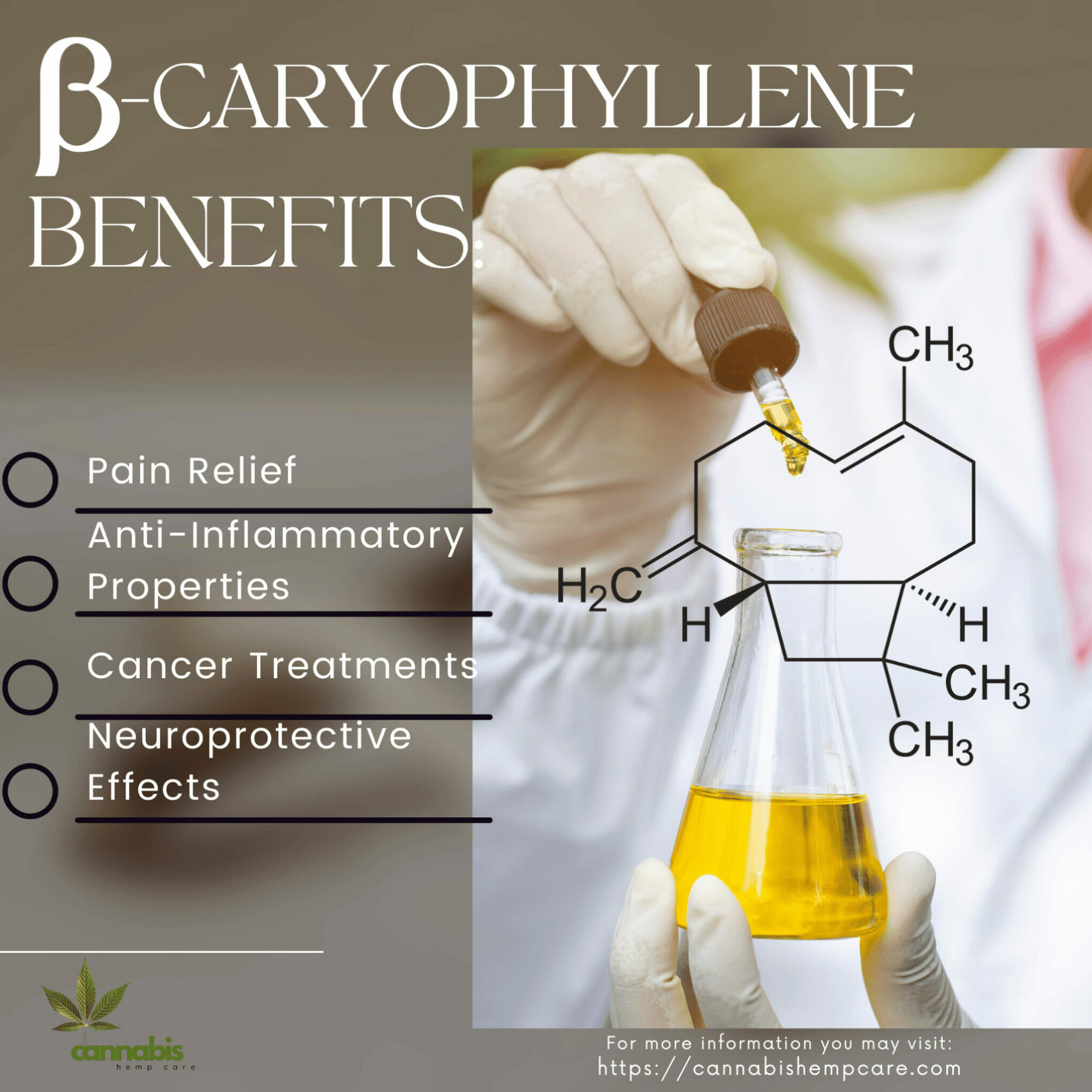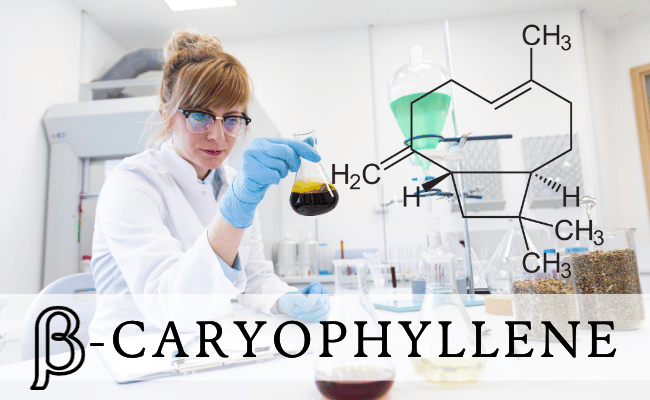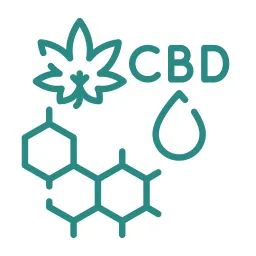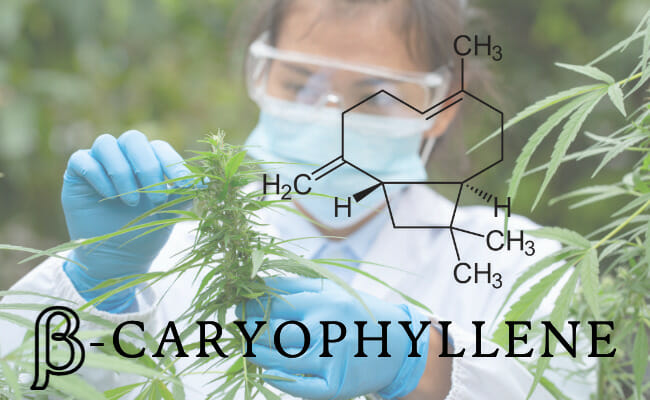When the term “cannabis” is mentioned, what usually comes to mind are the psychoactive effects attributed to THC. However, cannabis and other plant essential oils contain a myriad of chemical compounds that have significant therapeutic properties.
Among these is β-Caryophyllene, a major constituent of several essential oils, most notably found in black pepper, Cannabis sativa, and clove oil.1 This molecule has garnered significant attention within the pharmaceutical sciences due to its multifaceted interactions with the endocannabinoid system and beyond.
What is Beta Caryophyllene?
β-Caryophyllene is a natural bicyclic sesquiterpene. Terpenes, to define, are a large class of organic compounds produced by plants. They’re responsible for the aroma and flavor of numerous plant species.
Beta-caryophyllene is special because of its dual role: it functions as a dietary cannabinoid and a terpene.2 Commonly found in various essential oils, it plays a major role in their essential oil composition.
To simply explain:
Beta Caryophyllene is a natural compound found in many plants. It gives them a specific aroma and flavor. Think of it like a plant’s unique scent.
What makes it special? It can affect our body like some cannabis components do and is often found in essential oils.

Caryophyllene vs. Beta Caryophyllene
It’s crucial to differentiate caryophyllene from β-Caryophyllene. While they belong to the same family and share some chemical constituents, their effects, especially in interaction with the endocannabinoid system, are distinct. The molecular mechanisms behind these effects are still under rigorous investigation.
To simply explain, imagine you have two siblings in the same family. They both share the last name and some family traits, but they’re not twins and have unique personalities and characteristics. Now, let’s relate this to our topic:
Caryophyllene and β-Caryophyllene are like these two siblings.3 They belong to the same “family” of compounds, and they share some chemical features.
However, when it comes to how they interact with a particular system in our body (the endocannabinoid system), they act differently. Think of it as one sibling being good at basketball and the other at painting.
To further elucidate the differences and similarities between them, the following table provides a concise overview:
| Feature | Caryophyllene | For a specific type of apple, e.g., a Fuji apple, within the apple varieties |
|---|---|---|
| Family | Terpene family | Terpene family |
| Chemical Structure | Similar to beta-caryophyllene, but has its unique structure | A specific structure within the caryophyllene family |
| Endocannabinoid System Interaction | Interaction is less known | Known to interact distinctively with the endocannabinoid system |
| Analogy | Like an apple in the fruit family | Like a specific type of apple, e.g., a Fuji apple, within the apple varieties |
Beta-Caryophyllene Effects on the Endocannabinoid System
One of the unique beta-caryophyllene terpene effects is its interaction with cannabinoid receptors, specifically the CB2 receptors. Unlike THC, which affects the central nervous system by interacting with CB1 receptors and causing psychoactive effects, β-Caryophyllene selectively binds to CB2 receptors.
These receptors are predominantly expressed in immune cells, suggesting a significant role in immune responses.
Beta-caryophyllene Benefits:

- Anti-Inflammatory Properties: The interaction of β-Caryophyllene with CB2 receptors has been linked to significant anti-inflammatory effects. Its ability to down-regulate inducible nitric oxide synthase and various inflammatory mediators provides the potential to treat conditions like intestinal inflammation.
- Pain Relief: Neuropathic pain, challenging to treat with conventional drugs, might find an ally in β-Caryophyllene. Its interaction with cannabinoid and possibly opioid receptors in peripheral tissues offers a novel route for pain mitigation.
- Cancer Treatments: Preliminary in vitro studies show that β-Caryophyllene may inhibit tumor growth. The molecular mechanisms behind this are linked to its interactions with numerous signaling pathways, affecting cellular proliferation and survival.
- Neuroprotective Effects: Alzheimer’s disease, a prevalent neurodegenerative disorder4, may potentially be managed better with the inclusion of β-Caryophyllene in treatment regimens. It’s believed to influence the endocannabinoid system, offering neuroprotective effects.
Dosage and Administration
While the therapeutic properties of β-Caryophyllene are promising, determining the right beta-caryophyllene dosage is essential. Oral administration is the most common method, but its poor water solubility can affect bioavailability. It’s often incorporated into essential oil blends for topical or aromatic use.5
Future Studies and Considerations
- Blood Brain Barrier Penetration: While CB2 receptors are mainly found outside the central nervous system, understanding how β-Caryophyllene interacts or penetrates the blood-brain barrier could open avenues for treating central nervous system disorders.
- Off-Target Effects: Every therapeutic agent, natural or synthetic, can have off-target effects. Comprehensive studies need to focus on understanding these for β-Caryophyllene.
- Comparison with Synthetic Cannabinoids: The growing interest in cannabinoids has led to the development of synthetic variants. Comparing the efficacy and safety of β-Caryophyllene with these can provide insights into its viability as a therapeutic agent.6

Conclusion
To put it simply, β-Caryophyllene stands as a beacon within the realm of natural therapeutic agents. Its dual role as a terpene and a cannabinoid provides it with a unique stance, making it an area of interest for future research in pharmaceutical sciences.
While we’ve scratched the surface of its potential, rigorous clinical studies are essential to harness its full spectrum of therapeutic benefits while ensuring safety. In a world leaning towards natural solutions for human health ailments, β-Caryophyllene indeed stands out with potential and promise.
FAQs on Beta Caryophyllene
How does beta-caryophyllene make you feel?
Beta-caryophyllene can offer a laid-back and euphoric experience, making you feel more relaxed and at ease.
Is beta-caryophyllene relaxing?
Yes, beta-caryophyllene is known to reduce anxiety and provide a relaxing effect to its users.
Can I use caryophyllene to help with sleep?
Certainly. Caryophyllene is a potent terpene that can be effective in treating insomnia, aiding in a restful night’s sleep.
Does beta-caryophyllene boost my appetite?
Yes, beta-caryophyllene is said to stimulate the appetite, making you feel more hungry.
Sources
- Gertsch, Jürg, et al. “Beta-Caryophyllene Is a Dietary Cannabinoid.” Proceedings of the National Academy of Sciences of the United States of America, vol. 105, no. 26, 1 July 2008, pp. 9099–9104, www.ncbi.nlm.nih.gov/pmc/articles/PMC2449371/, https://doi.org/10.1073/pnas.0803601105. ↩︎
- “Learning about the Terpene Caryophyllene with Ethos.” Ethoscannabis.com, ethoscannabis.com/learn/terpenes-beta-caryophyllene/#:~:text=How%20does%20beta%20caryophyllene%20make. Accessed 7 Sept. 2023. ↩︎
- PubChem. “Caryophyllene.” Pubchem.ncbi.nlm.nih.gov, pubchem.ncbi.nlm.nih.gov/compound/Caryophyllene. ↩︎
- Paes-Colli, Yolanda, et al. “Phytocannabinoids and Cannabis-Based Products as Alternative Pharmacotherapy in Neurodegenerative Diseases: From Hypothesis to Clinical Practice.” Frontiers in Cellular Neuroscience, vol. 16, 2022, p. 917164, pubmed.ncbi.nlm.nih.gov/35707521/, https://doi.org/10.3389/fncel.2022.917164. Accessed 8 Sept. 2023. ↩︎
- “What Is Caryophyllene and What Does This Cannabis Terpene Do?” Leafly, 5 Feb. 2019, www.leafly.com/news/science-tech/caryophyllene-terpene. Accessed 8 Sept. 2023. ↩︎
- Blanton, Henry, et al. “Cannabidiol and Beta-Caryophyllene in Combination: A Therapeutic Functional Interaction.” International Journal of Molecular Sciences, vol. 23, no. 24, 7 Dec. 2022, p. 15470, www.ncbi.nlm.nih.gov/pmc/articles/PMC9779834/, https://doi.org/10.3390/ijms232415470. Accessed 8 Sept. 2023. ↩︎




































